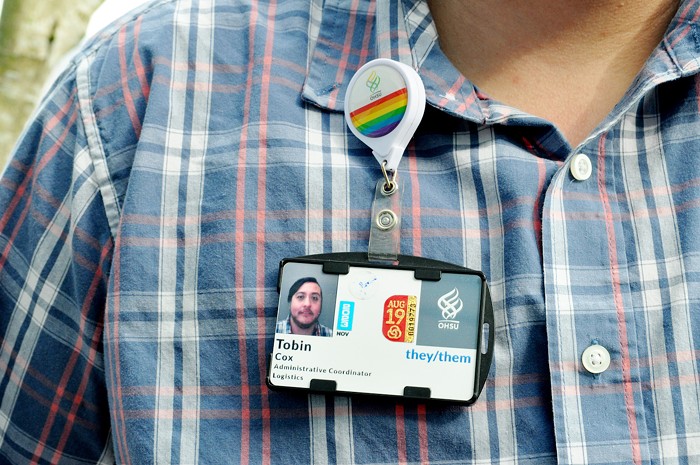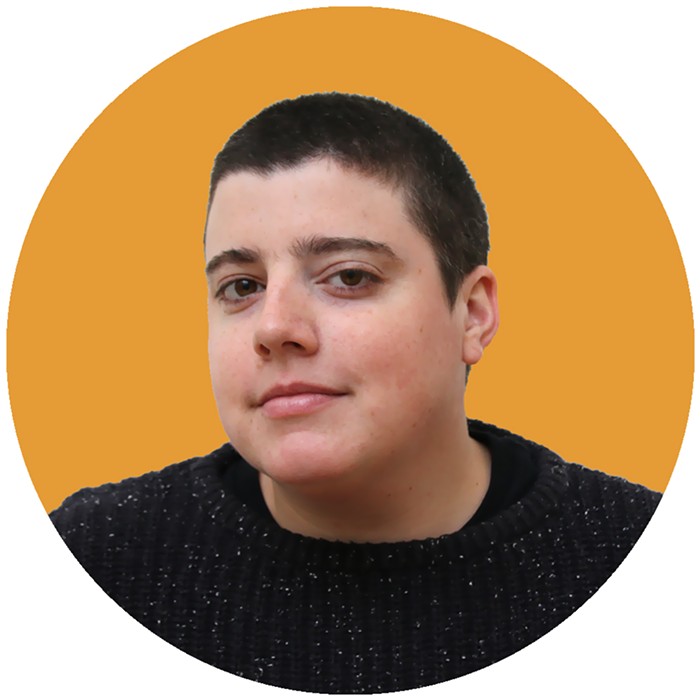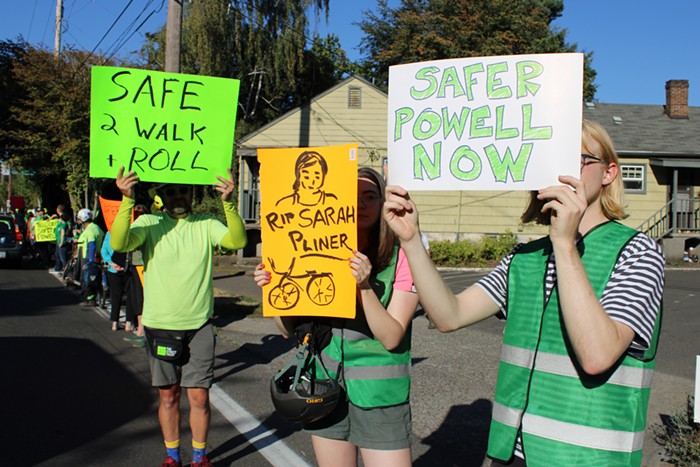When Molly Palmer came out as transgender in 2015—and decided to begin the process of a medical transition—she felt like her life was finally starting to come into alignment.
Palmer, 45, was eight when she began experiencing gender dysphoria—the anxiety and discomfort some trans people feel because their gender identity does not sync with the gender they were assigned at birth.
When she came out and began looking into hormone therapy, which would help her physical appearance match her gender identity, it was the same year the Oregon Health Plan began covering the cost of hormone therapy and most surgeries associated with a medical transition.
“I was like, ‘Okay, this is my chance. I have to do this. I’ve been waiting my whole life to do this,’” she says.
But when Palmer told her doctor she was ready to start hormone therapy, the doctor balked.
“She was like, ‘I don’t understand this. I don’t know how to handle this,’ even though my therapist had thoughtfully printed out some guidelines for hormone therapy,” Palmer says. Her doctor refused to write the prescription for estrogen.
“I felt really small at that moment,” Palmer says.
Palmer persisted, and after some research, stumbled upon Oregon Health & Science University’s (OHSU) Transgender Health Program.
She made an appointment at OHSU’s Richmond Family Medicine Clinic, where she received care from a family nurse practitioner, Allison Fox, who had experience with trans patients and was supportive of her choice to transition. The nurse practitioner treated Palmer with respect and wrote her a prescription without hesitation.
Palmer also underwent chest surgery (also known as top surgery) at OHSU, and she’s considering pursuing other procedures. Palmer says OHSU’s services have been life-changing for her.
“I used to be seriously reclusive, and tried to see people as little as possible,” she says. “That made my depression so much worse. Since I’ve medically transitioned, I’ve felt comfortable being out and talking to people”
Palmer is one of the thousands of patients to take advantage of services offered by OHSU’s Transgender Health Program (THP) since its inception in 2015. While other trans health programs exist in Portland and around the country, OHSU’s THP is one of the only programs to provide a comprehensive slate of trans medical services, educate medical professionals inside and outside of its system on trans issues, and provide the space and infastructure for a grassroots-like network of mostly trans volunteers.
The THP was created by a group of OHSU faculty and community members who recognized a lack of accessibility for new trans patients at OHSU. There is no centralized THP clinic, as it is an interdisciplinary program, although different OHSU departments do operate trans-specific clinics a few times a month. The THP’s website and direct phone line function as access points for many trans patients, medical providers, and community organizations—the program fielded about 3,800 inquiries in 2018 alone. The program helps connect trans patients with OHSU doctors representing a wide range of specialties, and offers informational sessions for patients focused on different aspects of a medical transition. It currently has just two full-time employees—a supervisor and an intake referral specialist—though a third employee, a mental health specialist, is expected to join soon.
THP supervisor Amy Penkin was the program’s first employee. She says her initial impression of the project was “really, really positive,” but the challenges were “daunting.”
“What needed to happen was pretty clear,” Penkin says. “It was really about looking at the individual’s pathway through our system... [and] considering every touchpoint they would have on their journey.”
Palmer says that every doctor she’s seen at OHSU has been gender-affirming, meaning they use the correct pronouns and name, and do not explicitly or implicitly question her gender identity.
But that isn’t the case for every trans patient at OHSU. Penkin says she often receives feedback from patients, or from her network of THP volunteers—two groups that often overlap—about being misgendered by OHSU faculty or staff.
That problem can be partially blamed on the hospital’s technology. OHSU files patients records through a computer software called EpicCare. The way EpicCare currently displays patient records emphasizes the name and gender they were assigned at birth, even if it’s incorrect. If a medical professional doesn’t carefully consult the screen, it’s easy for them to misgender a patient.
“I’ve spent a considerable amount of time with our IT and Epic folks,” says Christina Milano, a physician at the Richmond clinic and one of THP’s founders. She says that while the current iteration of EpicCare is “not as fluid as it needs to be,” a major system upgrade expected in May will “significantly change how gender and affirmed pronouns and names are displayed.”
Another common complaint Penkin hears from trans patients is that the wait time for surgery can be long. Jens Berli, a plastic surgeon at OHSU who specializes in gender-affirming surgery (or surgeries associated with a medical transition) says it’s not uncommon for a patient to wait months just to receive an initial consult. To help expedite the process, OHSU will sometimes refer patients to other clinics in the area, but it’s rare to find a medical system that offers a list of gender-affirming surgeries as comprehensive as OHSU’s.
For example, OHSU is one of only two hospitals on the West Coast that regularly perform phalloplasty, or penis construction. Berli says there simply aren’t enough surgeons trained in this area of expertise to serve the growing number of trans people seeking gender-affirming surgeries.
“It’s really an unholy alliance of a huge backlog of patients not having had care, and a backlog of untrained providers,” Berli says. This imbalance results in “patients having access to insurance, but not access to surgeries.”
Berli predicts this problem is a generational one—and one that OHSU faculty can help solve. Next year, Berli will welcome OHSU’s first fellow in gender-affirming plastic surgery, and the OHSU medical students and residents who shadow Berli also currently receive training. In the past year, physicians from the University of Utah, Johns Hopkins University, and a medical system in Chicago have visited him for consults, so they can use his knowledge to inform their own work.
“The residents that graduate, they’re going to be trained in this type of surgery,” he says. “So in another 10 years, there won’t be this lack of trained providers as there is right now. My door is always open for visitors, and I share whatever it is I can share.”
Getting the cost of a medical transition covered by insurance is another challenge OHSU’s trans patients face. While the Oregon Health Plan (OHP) covers most gender-affirming surgeries, facial feminization surgery—a procedure often desired by transfeminine people—is not covered under the plan. Berli was part of a group of medical professionals and trans advocates who worked with OHP last year to establish grounds for an exception to this rule, and one of his patients was able to get their facial feminization surgery covered by OHP. He also works with the World Professional Association for Transgender Health (WPATH)—the body many insurance providers consult when deciding which medical transition procedures they will cover—to determine new standards of care.
Students have begun seeking out instruction from doctors like Berli and Milano.
“There are some definite centers for excellence for transgender health care, with OHSU being one of them—it’s not like that exists at every medical school,” says OHSU medical student Alex Sievert, who just wrapped up a six-month program shadowing Milano. “It was important for me to be somewhere that offers that, and there just aren’t a lot of options.”
Sievert watched his roommate transition in the early 2010s, and knows that trans medicine still suffers from a lack of trained and affirming providers. From working with Milano, he learned how important it was for trans patients to “feel seen and heard” when they started their medical transitions.
“We’re not trying to box them in or write their story for them,” he added. “There’s a common misconception that transition looks like one thing, like ‘Point A’ to ‘Point Z.’ But there’s such a spectrum of experience and what people desire out of their gender experience, so it was really important to make sure patients knew this was in their hands.”
What it means to be trans, nonbinary, genderqueer, or otherwise not cisgender varies greatly from person to person, as does the medical transition process. Some trans people feel content without a medical transition, while for others—like Palmer—having access to a medical transition can drastically improve their experiences.
Whether a trans person opts for a medical transition or not, accessing any kind of health care services can come with a host of challenges cisgender patients never have to think about: the fear of being misgendered during a routine doctor’s visit; having a receptionist at an emergency room use the name on one’s legal documents, rather than an affirming name; and doctors asking probing questions about gender identity even when addressing an issue that has nothing to do with gender, such as a broken limb. Trans people often delay or avoid accessing necessary medical care for these reasons.
Sievert says he doesn’t necessarily plan to go into a trans-specific medical field; at the moment, he’s interested in working at a community hospital or an emergency room. But wherever his work takes him, he’ll find ways to use what he learned working with Milano to make the experience of going to the doctor easier for trans patients.
“In every setting, there are health disparities that face LGBTQ people,” Sievert says. “It won’t be hard to find a place where I can intervene.”
In March, medical residents at OHSU participated in an Objective Structured Clinical Examination, or OSCE. Often pronounced by medical professionals as “oskie,” an OSCE is the medical equivalent of a mock trial, in which residents take part in a role-playing scenario where they must work with a “patient” played by an actor to determine the best course of action.
In March, OHSU hosted the first trans-specific OSCE on the West Coast. Residents worked through a scenario in which a nonbinary person asked to start hormone therapy.
“We’re really excited to roll that out, and hopefully do the same with medical students in a few years,” Milano says. She says she would also like to someday build a trans health elective for OHSU students.
When designing the OSCE, OHSU faculty worked closely with THP, specifically with its volunteer network. Most THP volunteers are trans, and many are also OHSU patients.
Tobin Cox is a THP volunteer, an OHSU patient, and an OHSU employee. Cox, who identifies as nonbinary and uses they/them pronouns, was excited to offer guidance for the OSCE.
“Honestly, the most universal need right now is for doctors who are able to start [hormone therapy],” they say. “The most basic thing we’re hearing from folks outside of Portland is the need for primary physicians who know how to do that.”
After the OSCE concluded, THP volunteers participated in an hour-long panel, answering residents’ questions about how to treat trans patients.
The THP volunteer network provides valuable feedback for Penkin and others at OHSU—the program hosts a monthly, informal community meeting where trans patients and volunteers can give their input on making OHSU a more trans-affirming place, and offer advice directly to OHSU medical professionals. But some trans community members wanted more direct influence over the program’s direction. Penkin is organizing an official community advisory board, which will be made up exclusively of trans people who have been patients at OHSU.
“That will be a more formalized mechanism for ensuring we are involving community members and patients, and seeking their input,” Milano says. “I think this is a really important step for us, and reflective of what has always been our intention, but that hasn’t manifested the way we wanted it to.”
In addition to advising OHSU, THP’s volunteers also rely on each other for support. At community picnics and in social media groups, the members give each other advice and guidance that might be missing elsewhere in their lives. Volunteers formed a peer support group called Here4You, in which patients preparing for a particular surgery get paired with volunteers who have already undergone it. The “4” in the group’s name refers to the fourth floor of the OHSU hospital, where many trans patients recover after gender affirmation surgery. If a trans patient doesn’t have a family member or friend to support them before and after a surgery, a Here4You volunteer will fill that role.
“I think what’s happening here, this volunteer base, it’s kind of awesome—it’s very Portland.”
Cox says the grassroots nature of THP’s volunteer network reminded them of their roots in LGBTQ activism, and helped them find new friends when they moved to Portland from the San Francisco Bay Area and began transitioning.
“I think what’s happening here, this volunteer base, it’s kind of awesome—it’s very Portland,” they say. “I don’t know if I would have transitioned—at least not as easily as I did—if I had been living in the Bay Area. And that’s so weird to say, given how progressive the Bay Area is.”
The THP periodically hosts patient education sessions for people interested in accessing gender-affirming surgery. For Palmer, these sessions were a chance for her to learn without the pressure of—and long wait time for—a one-on-one consult with a surgeon.
“Wow, this is pretty accessible, and I feel pretty comfortable here, taking in information without having to talk,’” she remembers thinking.
Though patient needs are put at the forefront of the THP’s work, the program also works to create a more trans-inclusive environment for everyone at OHSU. THP led the effort to create gender-neutral signage for all OHSU restrooms, and give employees, students, and volunteers the option to include pronouns on their OHSU badges.
Another crucial aspect of THP’s work is providing education for OHSU employees, and for medical professionals outside the OHSU system.
Cox volunteers at the trainings THP holds for medical professionals, and at a recent educational session for OHSU’s perioperative services, which provide pre- and post-surgery care, Cox took questions. One woman in scrubs said that during patient intake, she has to confirm the person’s legal name. If a trans patient had a legal name that didn’t match their gender identity and gender-affirmed name, she asked, how could she confirm it in a respectful way?
“It’s hard, but I think a lot of us know that has to happen,” Cox answered. “As long as there’s an acknowledgement that, ‘I legally have to ask this’—letting folks know you have to ask those questions—there’s a kindness and compassion with that kind of thing.”
Cox says most of the questions they field at these sessions fall into that category: earnest queries from medical providers who want to show respect to their trans patients. But sometimes they encounter doctors who aren’t as well-versed in trans issues.
They recalled one THP-facilitated session when a rural doctor asked a question about medical intake forms, which generally ask for a patient’s gender.
“What am I supposed to do with these forms?” Cox remembers the doctor asking. “You want us to take gender out of these forms—but boys are boys, and girls are girls, and that’s just anatomy.”
“I’ll be honest,” Cox says, “there were some volunteers who have always been even-keeled, [but] the question was asked in such a way that it was hard not to be defensive with that.”
Cox, the other volunteers, and Penkin did their best to answer the doctor’s question. After the session ended, Cox and Penkin continued their conversation with the doctor. The discussion shifted Cox’s view of him.
“Here’s someone who’s really struggling, because of generational issues, but is still making an effort,” they say. “He sat through a whole day of class and instruction, and he came from far away to do it. He was obviously there to try to learn.”
And it’s in those more rural areas where education is most desperately needed. Molly Palmer is now a volunteer with Trans Lifeline, which operates a peer support hotline for trans people, and she regularly fields calls from people who, due to financial or geographical barriers, do not have access to gender-affirming medical care.
Palmer can relate to those callers. She says she sometimes regrets waiting until her 40s to come out as trans, but that she “didn’t feel like there was access then to care and help” for her to successfully transition. She doubts whether she would have been able to afford a medical transition herself if it wasn’t covered by the OHP.
Palmer says her experience transitioning, with the help of THP, has been “like a dream come true.”
“I feel like I was given a second chance at life,” she says, “so I’m giving it my all.”




















